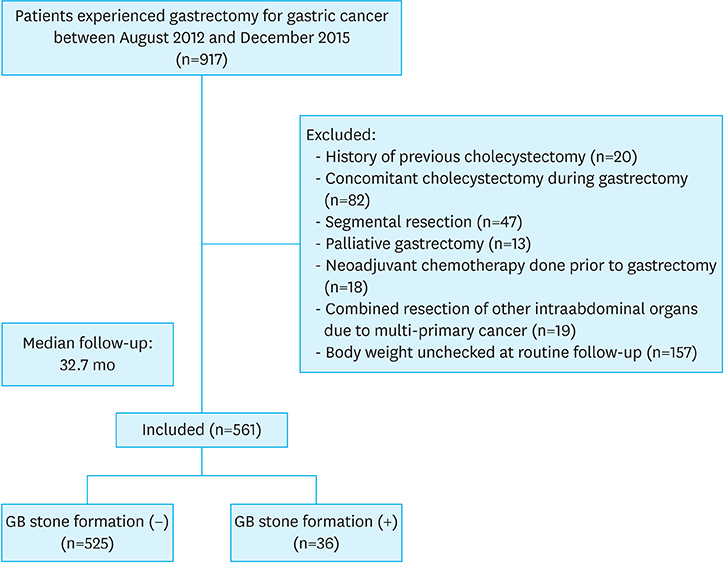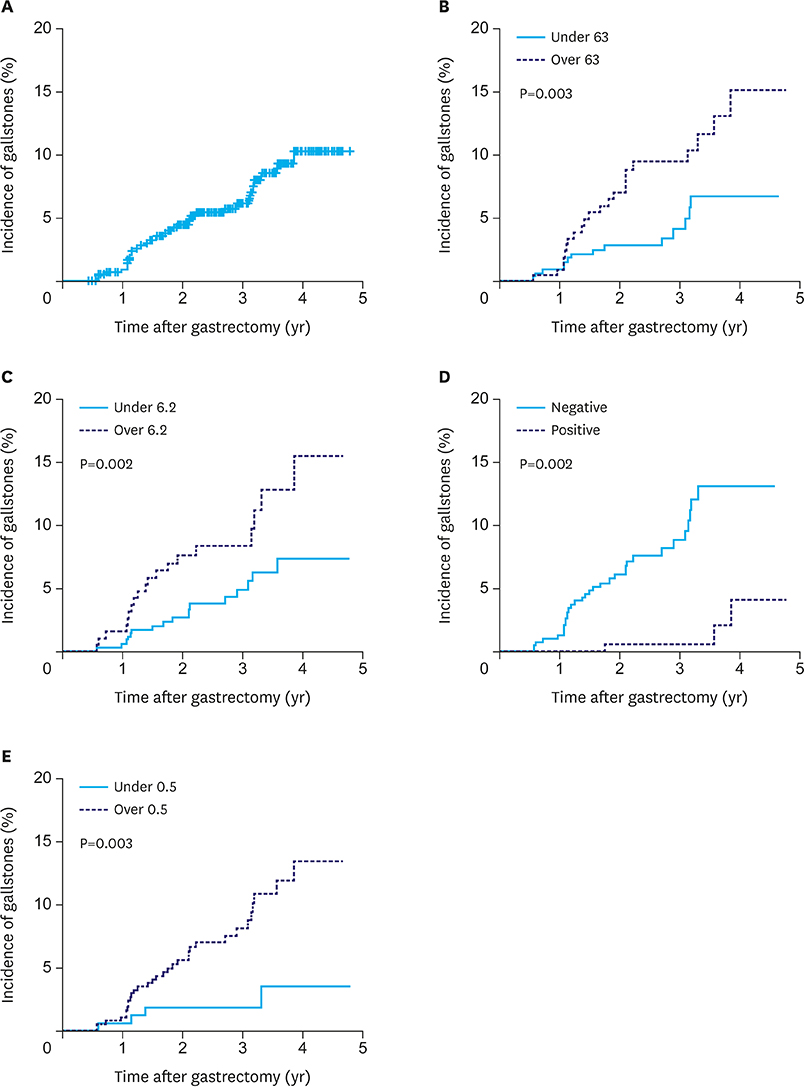J Gastric Cancer.
2019 Dec;19(4):417-426. 10.5230/jgc.2019.19.e37.
Risk Factors for Gallbladder Stone Formation after Gastric Cancer Surgery
- Affiliations
-
- 1Division of Stomach Surgery, Department of Surgery, Asan Medical Center, University of Ulsan College of Medicine, Seoul, Korea. medigang@hanmail.net
- 2Department of Clinical Epidemiology and Biostatistics, Asan Medical Center, University of Ulsan College of Medicine, Seoul, Korea.
- KMID: 2466030
- DOI: http://doi.org/10.5230/jgc.2019.19.e37
Abstract
- PURPOSE
Although an increased incidence of gallbladder (GB) stone formation after gastrectomy has been reported, its etiology remains uncertain. The goal of this study was to explore the incidence of gallstone formation after gastrectomy in gastric cancer patients and investigate the risk factors therein.
MATERIALS AND METHODS
Medical records of patients who underwent curative gastrectomy, performed by a single surgeon between August 2012 and December 2015 at the Asan Medical Center, were retrospectively reviewed. Baseline characteristics and surgical outcomes, including GB stone gallstone formation after gastrectomy, were analyzed.
RESULTS
Of 561 patients included in the study, 36 presented with GB stone formation after gastrectomy for gastric cancer. The incidence of gallstone formation was 6.4%. The mean interval between gallstone formation and gastrectomy was 21.9 months. In multivariate analyses, the incidence of gallstone formation increased in patients 63 years or older, with greater than 6.2 kg weight loss in the first 6 months after the procedure, a preoperative serum total bilirubin level greater than 0.5 mg/dL, and in patients who did not receive adjuvant chemotherapy.
CONCLUSIONS
This study presented risk factors for GB stone formation after gastric cancer surgery, and special attention should be afforded to patients with such risk factors.
MeSH Terms
Figure
Reference
-
1. Ahn HS, Lee HJ, Yoo MW, Jeong SH, Park DJ, Kim HH, et al. Changes in clinicopathological features and survival after gastrectomy for gastric cancer over a 20-year period. Br J Surg. 2011; 98:255–260.2. Choi IJ. Gastric cancer screening and diagnosis. Korean J Gastroenterol. 2009; 54:67–76.3. Park CH, Song KY, Kim SN. Treatment results for gastric cancer surgery: 12 years' experience at a single institute in Korea. Eur J Surg Oncol. 2008; 34:36–41.4. Liang TJ, Liu SI, Chen YC, Chang PM, Huang WC, Chang HT, et al. Analysis of gallstone disease after gastric cancer surgery. Gastric Cancer. 2017; 20:895–903.5. Lai SL, Yang JC, Wu JM, Lai IR, Chen CN, Lin MT, et al. Combined cholecystectomy in gastric cancer surgery. Int J Surg. 2013; 11:305–308.6. Hauters P, de Neve de Roden A, Pourbaix A, Aupaix F, Coumans P, Therasse G. Cholelithiasis: a serious complication after total gastrectomy. Br J Surg. 1988; 75:899–900.7. Pezzolla F, Lantone G, Guerra V, Misciagna G, Prete F, Giorgio I, et al. Influence of the method of digestive tract reconstruction on gallstone development after total gastrectomy for gastric cancer. Am J Surg. 1993; 166:6–10.8. Nakamura K, Ogoshi K, Makuuchi H. Clinicopathological study of cholelithiasis following gastric cancer surgery. Eur Surg Res. 2005; 37:29–35.9. Paik KH, Lee JC, Kim HW, Kang J, Lee YS, Hwang JH, et al. Risk factors for gallstone formation in resected gastric cancer patients. Medicine (Baltimore). 2016; 95:e3157.10. Park DJ, Kim KH, Park YS, Ahn SH, Park J, Kim HH. Risk factors for gallstone formation after surgery for gastric cancer. J Gastric Cancer. 2016; 16:98–104.11. Fukagawa T, Katai H, Saka M, Morita S, Sano T, Sasako M. Gallstone formation after gastric cancer surgery. J Gastrointest Surg. 2009; 13:886–889.12. Wu CC, Chen CY, Wu TC, Iiu TJ, P'eng PK. Cholelithiasis and cholecystitis after gastrectomy for gastric carcinoma: a comparison of lymphadenectomy of varying extent. Hepatogastroenterology. 1995; 42:867–872.13. Akatsu T, Yoshida M, Kubota T, Shimazu M, Ueda M, Otani Y, et al. Gallstone disease after extended (D2) lymph node dissection for gastric cancer. World J Surg. 2005; 29:182–186.14. Kodama I, Yoshida C, Kofuji K, Ohta J, Aoyagi K, Takeda J. Gallstones and gallbladder disorder after gastrectomy for gastric cancer. Int Surg. 1996; 81:36–39.15. Jun KH, Kim JH, Kim JJ, Chin HM, Park SM. Retrospective analysis on the gallstone disease after gastrectomy for gastric cancer. Gastroenterol Res Pract. 2015; 2015:827864.16. Kobayashi T, Hisanaga M, Kanehiro H, Yamada Y, Ko S, Nakajima Y. Analysis of risk factors for the development of gallstones after gastrectomy. Br J Surg. 2005; 92:1399–1403.17. Tompkins RK, Kraft AR, Zimmerman E, Lichtenstein JE, Zollinger RM. Clinical and biochemical evidence of increased gallstone formation after complete vagotomy. Surgery. 1972; 71:196–200.18. Wang DQ. Aging per se is an independent risk factor for cholesterol gallstone formation in gallstone susceptible mice. J Lipid Res. 2002; 43:1950–1959.19. Reshetnyak VI. Concept of the pathogenesis and treatment of cholelithiasis. World J Hepatol. 2012; 4:18–34.20. Rehnberg O, Haglund U. Gallstone disease following antrectomy and gastroduodenostomy with or without vagotomy. Ann Surg. 1985; 201:315–318.21. Tsai CJ, Leitzmann MF, Willett WC, Giovannucci EL. Weight cycling and risk of gallstone disease in men. Arch Intern Med. 2006; 166:2369–2374.22. Ura K, Sarna SK, Condon RE. Antral control of gallbladder cyclic motor activity in the fasting state. Gastroenterology. 1992; 102:295–302.23. Inoue K, Fuchigami A, Higashide S, Sumi S, Kogire M, Suzuki T, et al. Gallbladder sludge and stone formation in relation to contractile function after gastrectomy. A prospective study. Ann Surg. 1992; 215:19–26.24. Stinton LM, Shaffer EA. Epidemiology of gallbladder disease: cholelithiasis and cancer. Gut Liver. 2012; 6:172–187.
- Full Text Links
- Actions
-
Cited
- CITED
-
- Close
- Share
- Similar articles
-
- Cholelithiasis as a Risk Factor for Gallbladder Cancer
- A Comparative Study of Bile Compositions From patients with Gallbladder Stones and Common Bile Duct stones
- Incidence of Gallbladder Stones in Renal Transplant Recipients
- Risk Factors of Gastric Cancer and Lifestyle Modification for Prevention
- Acute Cholecystitis Associated with Gallbladder Metastasis of Gastric Cancer



